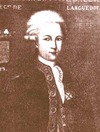WAXAWAY (Wexar, Assurowlaway, Prince Waxaway, in Abenaki wasάliαl∂we, “Snow Tail”), dogique, and subchief of the Norridgewock division of the Abenakis; fl. 1694–1710.
Waxaway resided at Amassokanty (now Farmington Falls, Me.). Early in July 1694 Waxaway took part in a dog feast of war that was held there. He enlisted with Bomoseen and on the 18th (o.s.) participated in the furious attack on Oyster River (Durham, N.H.) by that chief and Claude-Sébastien de Villieu. Evidently deeply affected by the slaughter Waxaway later ransomed one of Bomoseen’s captives, Mrs Ann Jenkins, helped several other prisoners, and thereafter inclined towards pacifism.
From 1694 to 1701 Waxaway served as dogique, or religious assistant, to Father Vincent Bigot at the Amassokanty mission. He spoke good English and was known to English prisoners as “the Indian minister” and “Prince Waxaway.” In September 1698 and October 1701, he probably accompanied Bigot to Canada, visiting the Abenaki missions of Saint-François de Sales (probably modern Beauceville) and Saint-Joseph de Sillery (near Quebec). Waxaway seems to have been the English-speaking chief who attended a conference with the New England deputies at Falmouth (now Portland, Me.) on 3 and 4 June 1701. He told Father Bigot that he had valiantly defended the Roman Catholic religion to which he attributed his success in overcoming his previous drunkenness. On 20 June 1703 he and other Abenaki chiefs signed a peace treaty with Massachusetts at Falmouth. Although war broke out less than two months later, Waxaway kept the peace and did much to alleviate the suffering of English captives.
Father Bigot had been recalled from the mission in 1701, and in 1704 many of the residents of Amassokanty moved to Canada to settle at Bécancour. Waxaway and others later moved to Norridgewock (Old Point, in south Madison, Me.). He probably spent the winter of 1708–9 in Canada, since he is not listed in the La Chasse* census of Indians on the Kennebec in November of 1708.
At Norridgewock the next winter an Indian, almost certainly Waxaway, purchased Lieutenant Josiah Littlefield of Wells, Me., from his Canadian Abenaki “master” to spare the ailing prisoner the hazardous winter trip to Canada. Littlefield wrote Governor Joseph Dudley of Massachusetts that the “Norridgewock Indian” had nursed him back to health, and had “been like a father.” The following summer Littlefield’s new owner led some 50 Abenakis of the peace party to Falmouth, where they complained of “unfair treatment” by English fishermen while under a flag of truce. They were not well received by the commander, Captain Samuel Moodey. Waxaway released Littlefield, but was justly disappointed when he received no reward. He told Lieutenant Joseph Bean, second in command, that “the french were very Angry” with the peace party for bringing Littlefield to the fort, and “haveing now no Commerce with them [the French], were come for a Supply from the English.” Again they were disappointed.
Waxaway’s later life and the date of his death are not known.
Newberry Library, Ayer Coll., La Chasse census (1708). [Vincent Bigot], Relation de ce qui s’est passé de plus remarquable dans la mission des Abnaquis à l’Acadie, l’année 1701 (Manate [New York], 1858), 8–10. Coll. de manuscrits relatifs à la N.-F., II, 495. Documentary hist. of Maine, IX, 276, 302–3; X, 94–95. Hutchinson, Hist. of Mass.-bay (1768), II, 171. New Eng. Hist. and Geneal. Register, XVIII (1864), 163–64. Penhallow, Hist. of wars with Eastern Indians (1726), 2. Province and court records of Maine, V, 23. E. E. Bourne, The history of Wells and Kennebunk from the earliest settlements to the year 1820 (Portland, Me., 1875), 267–73. Coleman, New England captives, I, 435–37.
© 1969–2024 University of Toronto/Université Laval
Cite This Article
Frank T. Siebert, Jr., “WAXAWAY,” in Dictionary of Canadian Biography, vol. 2, University of Toronto/Université Laval, 2003–, accessed April 26, 2024, http://www.biographi.ca/en/bio/waxaway_2E.html.
The citation above shows the format for footnotes and endnotes according to the Chicago manual of style (16th edition). Information to be used in other citation formats:
| Permalink: | http://www.biographi.ca/en/bio/waxaway_2E.html |
| Author of Article: | Frank T. Siebert, Jr. |
| Title of Article: | WAXAWAY |
| Publication Name: | Dictionary of Canadian Biography, vol. 2 |
| Publisher: | University of Toronto/Université Laval |
| Year of publication: | 1969 |
| Year of revision: | 1982 |
| Access Date: | April 26, 2024 |





